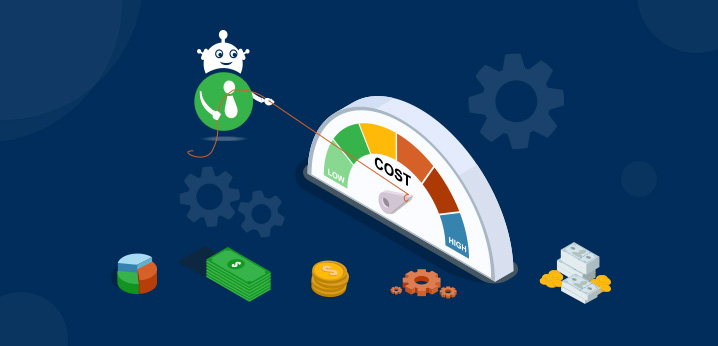
Cost Reduction Strategies for Banking: The Impact of Intelligent Automation on the Bottom Line
SHARE THIS:
In an era where financial institutions struggle with margin pressures, rising operational costs, and intensified competition, banks are in a perpetual search for strategies to help safeguard their bottom lines. Intelligent automation empowers banks to streamline operations, reduce manual processing costs, and improve accuracy and compliance — significantly enhancing their bottom line. This technology-driven approach enables banks to allocate resources more efficiently, focus on innovation and be prepared for strategic growth opportunities.
The High Cost of Traditional Banking Operations
Traditionally conservative in adopting new technologies, the banking sector is finding itself at a crossroads. The manual processes that are deeply ingrained in the back-office operations of many institutions are no longer sustainable. These antiquated practices not only drain resources, but also hamper the ability to provide customer-centric services promptly. From the cumbersome processing of loan applications to the manual reconciliation of accounts, the cost implications of these manual tasks are profound — impacting everything from employee productivity to customer satisfaction.
Introduction to Intelligent Automation in Banking
Intelligent automation integrates the adaptive capabilities of AI with the efficiency of RPA. Unlike its predecessors, intelligent automation can leverage data and processes across multiple, existing technology systems. As a result, intelligent automation marks the beginning of the end of the industry’s longstanding manual, repetitive processes.
Cost Reduction Through Intelligent Automation
Below are several ways in which intelligent automation is driving cost efficiencies in banking environments.
1. Back-Office Operations
Automated Account Reconciliation: Traditionally, reconciling accounts has been a labor-intensive process involving substantial human effort to match records with transactions. Intelligent automation can be used to automate these reconciliations, drastically reducing the time and potential for errors, which saves on labor costs and avoids financial discrepancies.
Compliance Reporting: Regulatory reporting requires accuracy and can be highly resource-intensive. Intelligent automation automates the extraction, processing, and filing of these reports, ensuring compliance with laws like KYC (Know Your Customer) and AML (Anti-Money Laundering) with minimal human intervention. This not only reduces operational costs but also lowers the risk of costly regulatory fines.
Document Processing and Management: Intelligent automation uses technologies like Optical Character Recognition (OCR) and Natural Language Processing (NLP) to automate the processing of numerous forms and documents, from customer application forms to internal reports. This automation reduces the need for physical storage, decreases processing errors, and minimizes the staff required for document management tasks.
2. Customer Service
AI-Powered Digital Workers: These tools handle inquiries and transactions around the clock, from balance inquiries to complex transaction disputes, without the overhead costs associated with human operators. By deflecting common inquiries to bots, banks can reserve human agents for more complex issues, thereby optimizing labor costs.
Personalization of Customer Interactions: By using automation to aggregate customer data, banks can offer personalized advice and solutions efficiently, increasing customer satisfaction and retention while reducing the time spent per customer interaction.
3. Fraud Detection and Compliance
Fraud Prevention: Intelligent automation systems can monitor transaction activity in real time, with automations set up to identify anomalies that may indicate fraudulent activities. By catching fraud earlier, banks can avoid the substantial costs associated with fraud, including monetary losses and reputational damage.
Automated Regulatory Change Management: Automations can be programmed to update compliance processes automatically as new regulations are enacted. This agility prevents compliance breaches and the significant fines associated with them, while also reducing the need for costly legal consultations.
4. Loan Processing
Automation of Credit Scoring and Risk Assessment: Intelligent automation dramatically speeds up the credit scoring process by aggregating data from various sources instantaneously, thus reducing the manpower needed and improving the speed and accuracy of risk assessments.
Document Verification: Automation tools verify the authenticity and accuracy of loan application documents in a fraction of the time required for manual checks, significantly speeding up the loan approval process and reducing labor costs.
Workflow Optimization: By automating workflows in the loan processing pipeline, banks can ensure that applications are processed smoothly without bottlenecks, reducing the cycle time from application to disbursement and improving the customer experience.
Conclusion
By integrating intelligent automation across these areas, banks not only achieve direct cost reductions, but also enhance their agility, compliance, and customer satisfaction — leading to higher retention rates and new revenue opportunities. The strategic deployment of intelligent automation is not merely a cost-cutting exercise, but a foundational transformation that positions banks as more responsive, efficient, and competitive entities in the financial sector.
About HuLoop Automation
Based in the Sacramento, California area, HuLoop Automation serves enterprises who are digitally transforming their businesses to maximize human productivity and improve customer experience, all while leveraging existing technology investments. HuLoop has built a unified automation platform to help enterprises automate manual, mundane tasks, so their human talent is able to spend time on higher value work. Our AI-based, codeless, Human-in-the-Loop software eliminates mind-numbing work, saving our clients’ money and improving employee satisfaction. Learn more at www.huloop.ai and follow HuLoop on LinkedIn, Facebook and X (formerly known as Twitter).